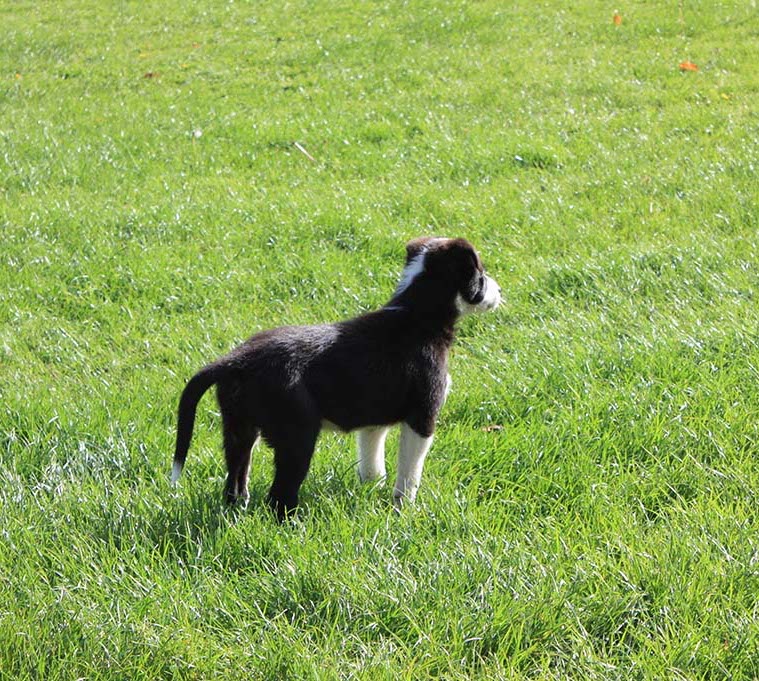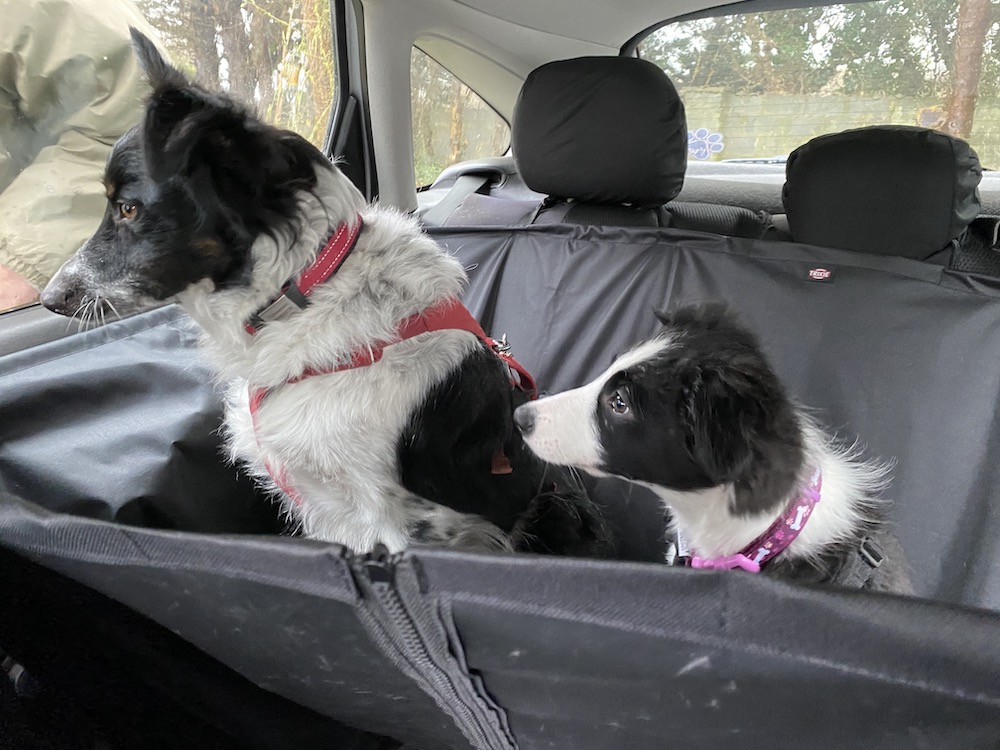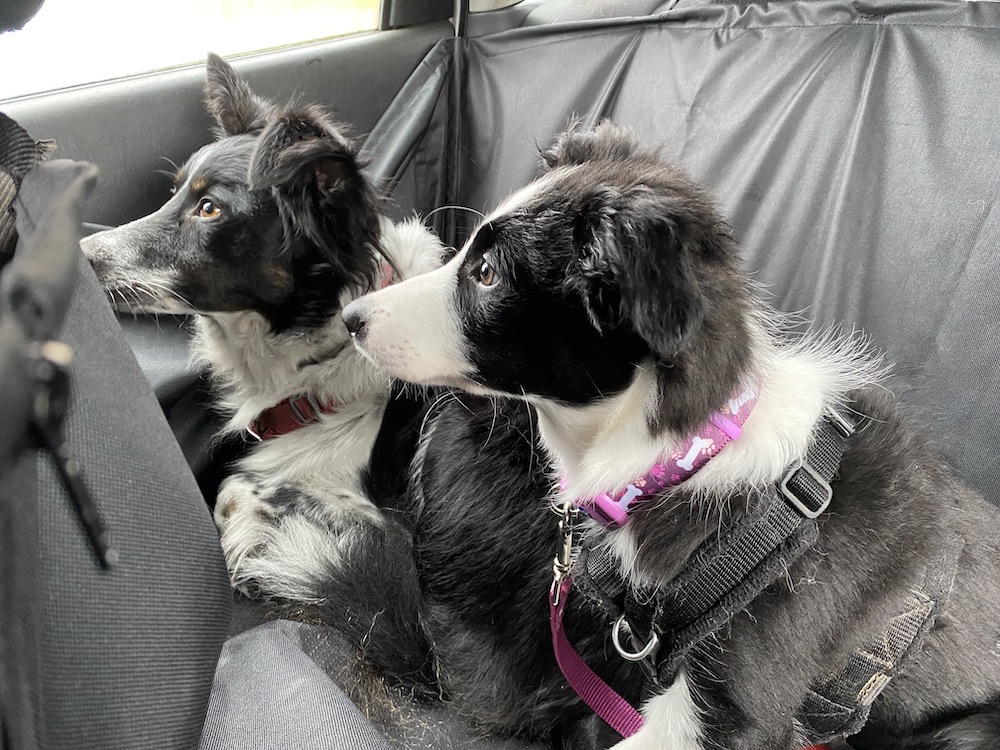Nika and the Big Wide World

“Nika, if I’m going to take you to a football match, the least you could do is stay awake for it.”
To be fair, I’m not entirely sure it was football. I know it wasn’t rugby or golf. But beyond that I can’t say for certain.
And we weren’t exactly at the match. We were sitting in the car in a carpark next to a sportsground. Nor had we intended to show up at the time a match was being played. We’d just intended to be in a car park, and sometimes in a car park these things happen.

I want Nika to learn about the world; to learn that there are things that happen “out there” or “over there,” to which she doesn’t need to attend.
Here, I’m not thinking in terms of windows of socialisation that might slam shut and crush my fingers unless I shove Nika through them before she’s only a few months old. The guidance on bringing puppies to multiple new environments to encounter a range of different stimuli in their first couple of months in their home seems to leave too much to chance for my liking: novel environments with unexpected stimuli approaching from various directions, and with the puppy’s responses as yet unobserved and unaccounted for; no easy way of retreating if it goes wrong; an insistence that food can be used to change emotional responses (even though certain emotional reactions shut down the digestive system so that food is not appetising at that time).
Too often I hear stories and see examples of this going wrong: an “it’s okay he’s friendly” dog barging towards them, a socially immature puppy making assumptions about who wants to be greeted and how, an unpleasant event that potentially taints all of the stimuli encountered on the retreat from this place.
Amid the checklists of stimuli and envioronments found copiously online to which we are instructed we should introduce our pups, the “recipes” advise that we constantly assess how the puppy is feeling. Yet our ability to be objective when vigilant to both the puppy and the environment will be impaired as a matter of course: “Is that person coming towards us?”; “Does that dog look a bit uncomfortable?”; “Oh no; there’s a digger; better find a place to pull in.”
Nor are those checklists appropriate for the lifestyle we’ll live. Take Nika to a busy pub? What, so I can let her go in by herself? Because that’s not the kind of environment you’re likely to find me in. Umbrellas? It’s so windy here that the bearers are lofted so high in the air that they wouldn’t be visible. Skateboards? Unless the local farmers have traded in their tractors for this new mode of transport, I think I’ll save our precious time and energy for some learning that she’s likely to need. And here, of course, is the nub of the issue: the onus is on us to assess what learning our dogs require, rather than to take someone else’s word for it.
So instead of bringing Nika out and about to test her responses to various things in the world (some of which we might never encounter again) and to try to patch up any signs of discomfort, we settle into the learning of familiarisation instead.
We have a regular diet of novelty at home, new sensory experiences, and new learning to build her skills. And we spend a lot of time hanging about in car parks…

After Nika learned, through sitting in the stationary car in the drive, that it is a place of comfort and security, we were able to take that place of comfort and security out and about with us. We chill in the car while the world goes on around us, with ample space to observe and become familiar with all of the happenings “out there.” Nika encounters all of this novelty from a place of safeness and rest, and because I’m upright and she in the back with her brother, I get quite a bit of reading done without someone who shall remain nameless using me as a trampoline.
Together, at first with the windows closed, and later cracked to let in more of the sounds and smells, we’ve noticed but paid little attention to articulated lorries, families out for the day, all kinds of vehicles, multiple other dogs, and the oil man making a delivery. Well, I paid a little bit more attention to that last one because he walked right across my lawn and the newly sprouting spring bulbs. But I didn’t bark, as much as I was tempted…
In these places, whether at home or away, I’ve stepped out of the car, walked around it, disappeared from sight and returned, all the while ensuring that both dogs remained comfortable and relaxed, so that they learn that they are safe even when I am not present. This is valuable learning for Tighearnán too, and a regular part of his world, as he is used to coming with me on errands and waiting in the car while I go and do boring human stuff.
Our next step for Nika is to park up at spots that we’ll visit frequently, and leave the car and return to it several times, gradually stretching the distance we move from it so that Nika always knows where she is in relation to her place of comfort and security.
At no point do I want to dump my dogs into the middle of this Big Wide World and hope they have the skills to cope. Instead, familiarisation is about bringing the world to them and gradually fading all of its weirdness so that at every stage they have the skills to cope.
And who knows, maybe I’ll learn a thing or two about sport while I’m at it.








